
Millipedes are a group of arthropods that are characterised by having two pairs of jointed legs on most body segments; they are known scientifically as the class Diplopoda, the name derived from this feature. Each double-legged segment is a result of two single segments fused together. Most millipedes have very elongated cylindrical or flattened bodies with more than 20 segments, while pill millipedes are shorter and can roll into a tight ball. Although the name "millipede" derives from Latin for "thousand feet", no species was known to have 1,000 or more until the discovery in 2020 of Eumillipes persephone, which can have over 1,300 legs. There are approximately 12,000 named species classified into 16 orders and around 140 families, making Diplopoda the largest class of myriapods, an arthropod group which also includes centipedes and other multi-legged creatures.

Pauropoda is a class of small, pale, millipede-like arthropods in the subphylum Myriapoda. More than 900 species in twelve families are found worldwide, living in soil and leaf mold. Pauropods look like centipedes or millipedes and may be a sister group of the latter, but a close relationship with Symphyla has also been posited. The name Pauropoda derives from the Greek pauros and pous or podus, because most species in this class have only nine pairs of legs as adults, a smaller number than those found among adults in any other class of myriapods.
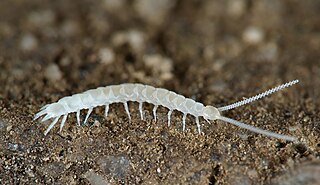
Symphylans, also known as garden centipedes or pseudocentipedes, are soil-dwelling arthropods of the class Symphyla in the subphylum Myriapoda. Symphylans resemble centipedes, but are very small, non-venomous, and only distantly related to both centipedes and millipedes. More than 200 species are known worldwide.
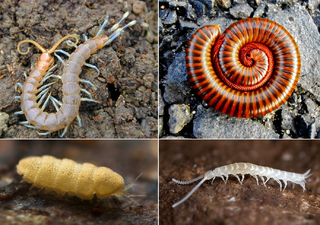
Myriapods are the members of subphylum Myriapoda, containing arthropods such as millipedes and centipedes. The group contains about 13,000 species, all of them terrestrial.

Pauropodidae is the most diverse family of pauropods, containing 27 genera and more than 800 species. This family has a subcosmopolitan distribution. These pauropods usually live in the soil on mountains and hills. This family also includes the only known fossil pauropod (Eopauropus).
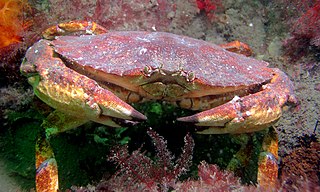
Cancer productus, one of several species known as red rock crabs, is a crab of the genus Cancer found on the western coast of North America. This species is commonly nicknamed the Pearl of the Pacific Northwest.
Pachymerium is a genus of centipedes in the family Geophilidae found mainly in the west Palearctic region and in south Africa. Centipedes in this genus feature an elongate head, scattered coxal pores, and sternal pores in a pair of anterior groups and a posterior transverse band; the forcipular coxosternite is broad, and the ultimate article of the forcipule has a prominent basal denticle.
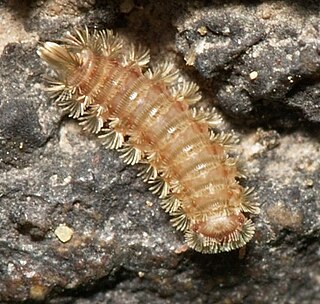
Polyxenida is an order of millipedes readily distinguished by a unique body plan consisting of a soft, non-calcified body ornamented with tufts of bristles. These features have inspired the common names bristly millipedes or pincushion millipedes. This order includes about 148 species in four families worldwide, which represent the only living members of the subclass Penicillata.
Millotauropus is a genus of pauropods in the monotypic family Millotauropodidae in the monotypic order Hexamerocerata. The order Hexamerocerata includes only eight species and was created in 1950 to contain the newly discovered genus Millotauropus, which was found to have so many distinctive features as to warrant placement in a separate order. Before the discovery of Millotauropus, for example, pauropods were thought to have no more than ten leg pairs, but adults in the order Hexamerocerata have eleven pairs of legs.
Tetramerocerata is an order of pauropods containing 11 families and more than 900 species. This order was created in 1950 to distinguish these pauropods from those in the newly discovered genus Millotauropus, which was found to have such distinctive features as to warrant placement in a separate order (Hexamerocerata) created to contain that genus. The order Tetramerocerata includes the vast majority of pauropod species, as there are only eight species in the order Hexamerocerata, which remains the only other order in the class Pauropoda.
Brachypauropodidae is a family of pauropods. This family has a nearly worldwide distribution. Pauropods in this family are found on all continents except South America and Antarctica.
Linotaeniidae are a monophyletic clade of soil centipedes in the family Geophilidae found mostly in the temperate regions of the Holarctic as well as the south Andes. Species in the clade Linotaeniidae are characterized by a body that usually tapers toward the anterior tip; mandibles with a single pectinate lamella; second maxillae with coxo-sternite usually undivided and claws without projections; forcipular segment short, with tergite remarkably wide, forcipules evidently tapering; coxal organs opening through distinct pores on the ventral surface of the coxo-pleura. The number of legs in this clade varies within as well as among species and ranges from as few as 31 pairs of legs to as many as 83 leg pairs. Compared to most families in the suborder Adesmata, this clade features a modest number of leg-bearing segments and limited variation in this number within each species.

Schendylidae is a family of soil centipedes in the superfamily Himantarioidea and the order Geophilomorpha. These centipedes are found in the Americas, the Palearctic region, Africa, Madagascar, Australia, and southeast Asia, and also on some Pacific islands. This family was first proposed by the American biologist Orator F. Cook in 1896.

Scolopendrellidae is a family of symphylans in the class Symphyla. There are about 9 genera and at least 100 described species in Scolopendrellidae.
Chileana is a genus of soil centipedes in the clade Linotaeniidae and family Geophilidae found in southern Chile. This genus currently includes only one species, C. araucanensis. Females of this species are about 30mm long, with a pale yellow body and a red head; bearing 12–15 pleural pores; long, tapering antennae with sparse basal sections and rather hairy distal sections; and a labrum with four median tubercles bearing a few cilia on the sides. Males have 10 pleural pores, thick ultimate legs armed with claws, and 43 leg pairs.
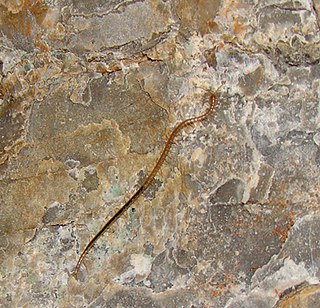
Ribautia is a genus of centipedes in the family Geophilidae. This genus was described by French myriapodologist Henry Wilfred Brolemann in 1909. Centipedes in this genus are found in South America, tropical Africa, Madagascar, the Arabian peninsula, Australia, New Zealand, and Melanesia.
Zygopauropus is a monotypic genus of pauropod in the family Brachypauropodidae. The only species in this genus is Zygopauropus hesperius, first described by J.W. MacSwain and U.N. Lanham of the University of California at Berkeley in 1948. This genus is notable as one of only four genera of pauropods in which adults have only eight pairs of legs rather than the nine leg pairs usually found in adults in the order Tetramerocerata. Before the discovery of Z. hesperius, adult pauropods were thought to have only nine or (rarely) ten pairs of legs.
Schendylops is the largest genus of centipedes in the family Schendylidae, containing more than 60 species. This genus was first proposed by the American biologist Orator F. Cook in 1899 for the type species originally named Schendyla grandidieri in 1897. Most species in this genus are found in the Neotropical region, but a dozen species are found in Africa and Madagascar. These species live in diverse habitats, ranging from sea level to high altitudes, e.g., at 4,500 m (14,800 ft) above sea level in the Andes mountains.
Decapauropus cuenoti is a species of pauropod in the family Pauropodidae. As the name of the genus Decapauropus suggests, this species is notable for including females with ten pairs of legs instead of the nine leg pairs usually found in adult pauropods in the order Tetramerocerata. Before the discovery of D. cuenoti, adult pauropods were thought to have invariably nine pairs of legs.









